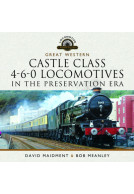The Early History of Railway Tunnels (Hardback)
Imprint: Pen & Sword Transport
Pages: 280
Illustrations: 80 mono illustrations
ISBN: 9781399049405
Published: 7th June 2024
(click here for international delivery rates)
Need a currency converter? Check XE.com for live rates
| Other formats available - Buy the Hardback and get the eBook for £1.99! | Price |
|---|---|
| The Early History of Railway Tunnels eBook (24.0 MB) Add to Basket | £14.99 |
To the early railway traveller, the prospect of travelling to places in hours rather than days hitherto was an inviting prospect, however a journey was not without its fears as well as excitement. To some, the prospect of travelling through a tunnel without carriage lighting, with smoke permeating the compartment and the confined noise was a horror of the new age. What might happen if we broke down or crashed into another train in the darkness? To others it was exciting, with the light from the footplate flickering against the tunnel walls or spotting the occasional glimpses of light from a ventilation shaft.
To the directors of early railway companies, planning a route was governed by expense and the most direct way. Avoiding hills could add miles but tunnelling through them could involve vast expense as the Great Western Railway found at Box and the London and Birmingham at Kilsby. Creating a cutting as an alternative was also costly not only in labour and time, but also in compensation for landowners, who opposed railways on visual and social grounds having seen their land divided by canals.
Construction involved millions of bricks or blocks of stone for sufficiently thick walls to withstand collapse. However, the entrance barely seen from the carriage window might be an impressive Italianate arch as at Primrose Hill, or a castellated portal worthy of the Middle Ages as at Bramhope.
This book sets out to tell the story of tunnelling in Britain up to about 1870, when it was a question of burrowing through earth and rock with spade and explosive powder, with the constant danger of collapse or flooding leading to injury and death. It uses contemporary accounts, from the dangers of railway travel by Dickens to the excitement of being drawn through the Liverpool Wapping Tunnel by the young composer Mendelssoln. It includes descriptions from early railway company guide books, newspapers and diaries. It also includes numerous photographs and coloured architectural elevations from railway archives.
"Overall I found the book an engrossing read and it is particularly useful in describing the reception and response to these early tunnels from the perspective of the many different stakeholders... it is refreshing to read about the days when majesty and magic ruled supreme."
Subterranea - The Magazine for Subterranea Britannica - Issue 69, September 2025
As the author points out, tunnels are, in transport literature, a neglected aspect of the physical structure of railways. This well-written study goes some way to filling this virtual “Black Hole”, and is aided by a full set of appendices and references.
Journal of the Railway & Canal Historical Society
The extensive bibliography is welcome evidence of the amount of primary research undertaken by the author... The large number of illustrations are well chosen, and well produced.
It is a thoroughly enjoyable read, and helps to fill the gap in railway literature identified by the author.
REVIEW OF THE MONTH
Steam World - February 2025
"This is an immaculately researched and thoroughly readable book."
"...overall this is an interesting work, filling a gap in railway literature. With an excellent cover picture of Sevenoaks Tunnel it is also an attractive volume."
Friends of the National Railway Museum Review - Summer 2024
About Hubert Pragnell
Hubert Pragnell is an architectural historian, teacher and artist, who has been fascinated by railways and their history since childhood. He was written several books on architectural and London history. For many years he has been a tutor for the Department for Continuing Education at Oxford and previously taught history of art at The King’s School, Canterbury. He studied fine art at the Ruskin School of Fine Art, Oxford, and holds a PhD from the University of York.















